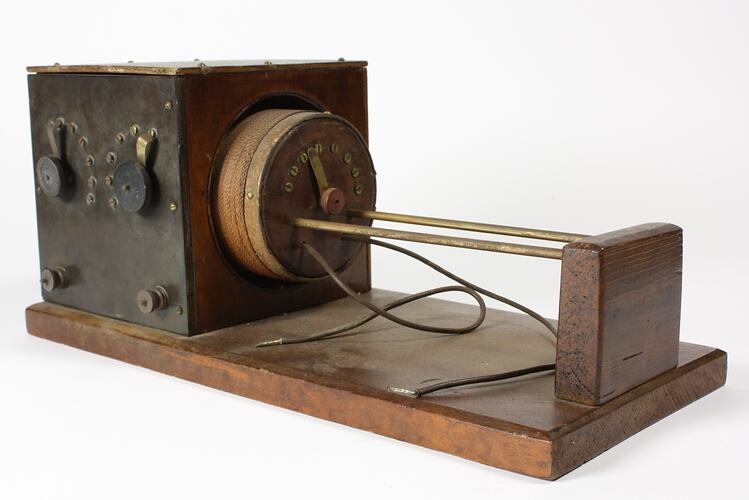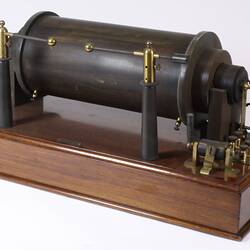Summary
A loose coupler or a receiving transformer, used in crystal sets.
This type of device was in general use 1910 - 1920s before being superseded. It has two separate tuning coils, a primary and a secondary, that are loosely coupled together. The term 'loose' refers to the fact the magnetic coupling between the coils is not particularly close. The secondary coil can slide in and out of the primary coil, and is connected to a detector. The primary coil is connected to an antenna and ground.
A crystal detector and tuning capacitor are connected to the two terminals at the end of the slide mechanism (the right end). An aerial and earth are connected to the two terminals on the box below the aerial coil tap selectors.
In order to receive a signal, the following adjustments must be made and possibly repeated to get the optimum performance (not a simple matter and easily upset):
The input coil (inside box) is adjusted to resonate at the desired receiving frequency using the two tap selectors on the front panel of the box.
The inductance of the secondary coil is set by its tapping switch and tuned by a capacitor (not present) to suit the frequency being received.
Moving the secondary coil in and out of the primary (in the box) allows coupling to adjusted for maximum performance. With coil pushed in, the sensitivity will be high and the selectivity will be poor. The reverse occurs with the coil pulled out.
The item seems to be homemade.
Physical Description
A square wooden box mounted at one end of a wooden base. Inside there is a cylinder wrapped with wire coiled around it. This cylinder can be moved in and out of the box along two metal rods. There are two sheathed wires protruding from the cylinder and a movable metal plate that can be connected to one of 8 pick ups (metal screws embedded in end of cylinder). One side of the box has two knobs with a blade that can be rotated to connect to one of the pick ups. There are also two terminals. There is a number handwritten in white ink underneath the base.
More Information
-
Collecting Areas
-
Manufacturer
Unknown Source, 1910-1925
The item seems to be homemade. -
Inscriptions
Under base: " L106 "
-
Classification
-
Category
-
Discipline
-
Type of item
-
Overall Dimensions
364 mm (Width), 163 mm (Depth), 160 mm (Height)
-
References
Information about loose couplers: "Also known as a "Receiving Transformer", loose couplers were used extensively in receivers built during the "teens". The coupler consists of two coils, a primary and a secondary. The primary coil is stationary and is usually provided with a slider for varying the inductance by single turns. The secondary coil slides in and out of the primary to vary the coupling, and is designed with several switch points in order to change its inductance. Loose couplers were used as the primary tuning device in early receivers. The primary coil was attached to an antenna and ground (sometimes through a variable condenser.) The secondary was connected to a detector (typically a crystal detector in the early sets)." [Link 1] - Retrieved 26 Aug 2010 (M. Vaughan)
-
Keywords

